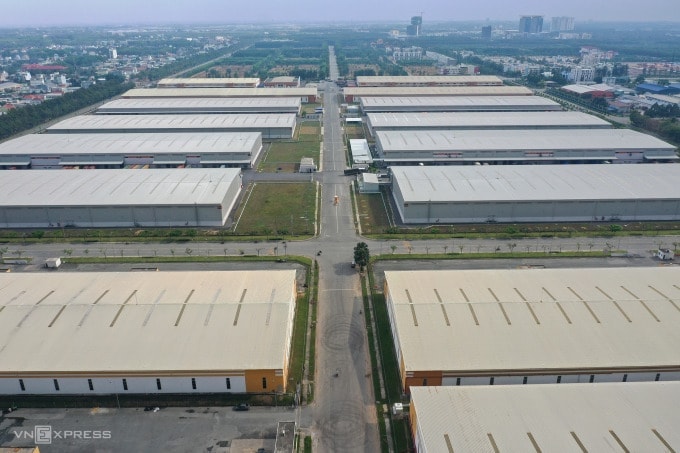Industrial real estate has more opportunities thanks to the trend of shifting supply chains to Vietnam, which was reinforced when Mr. Trump became President.

At the end of October, Vietnam Industrial Park started construction on a ready-built warehouse project in Nhon Trach VI Industrial Park (Dong Nai), with a leased floor area of more than 44,000 m2 in phase 1, expected to be completed in the second quarter of 2023. The group's representative said that it has broken ground on 4 projects nationwide since the beginning of the year, with a total area of 400,000 m2.
Also during this period, SLP Park, located in Nam Dinh Vu Industrial Park (Hai Phong), has the first bonded warehouse of logistics giant Maersk in Vietnam. The warehouse's first customer is Amazon. Maersk also said it will soon put it into operation at Lach Huyen port, which is being developed by APM Terminals and Hateco.
The booming industrial real estate market is in line with the clear trend of shifting production. "Vietnam is well-positioned to benefit from the global trade shift and changes in supply chains," commented Mr. Joon Suk Park, Head of International Business, HSBC Vietnam Corporate Banking.
FDI into Vietnam in the past 10 months reached 27.26 billion USD, up 1.9% over the same period. Realized capital increased 8.8%, 19.6 billion USD. According to the Foreign Investment Agency, many projects in the fields of semiconductors, energy equipment (batteries, photovoltaic cells, silicon bars), and electronics have received new investment and expansion.
This development is beneficial for industrial real estate developers. CBRE's report said that in the first 9 months of the year, the Southern market leased nearly 420,000 m2 of warehouses and 543,000 m2 of factories, nearly double the same period in 2023. In the North, the occupancy rate of ready-built factories reached 91%, up 9 percentage points. In the industrial land segment, rental prices continued to increase in both regions.
Analysis by real estate consulting firm Avison Young Vietnam shows that during Trump's first term (January 2017-January 2021), real estate and the processing and manufacturing industry benefited from the shift in FDI capital flows.
This trend has accelerated since the US-China trade war began in 2018. Accordingly, 2019 was the time when many Chinese and Taiwanese manufacturers came to the market. Chinese stationery company Deli operated its first factory in July in Yen Phong Industrial Park (Bac Ninh).
In the same year, Foxconn - Apple's partner expanded with the operation of the Fuyu Precision Component factory in Quang Chau Industrial Park (Bac Giang) and invested in the "S-Vietnam" project in Dong Mai Industrial Park (Quang Ninh). Goertek, which specializes in manufacturing electronic devices and audio components, built a factory in Que Vo Industrial Park (Bac Ninh). In addition, solar module manufacturer Longi joined and acquired the "Vina Solar" project from Ningbo Yize in 2020.
Real estate transactions in Vietnam have also increased. From 2017 to mid-year, the number of deals increased by nearly 20% compared to the period before Trump took office (2009-2016). Most transactions were recorded in the industrial real estate segment, followed by hotels and offices.
Under a second Trump term, the trade war would be more unpredictable, experts say. The announcement of a 60% tariff on Chinese imports and a 10-20% tariff on all imports could trigger retaliation not only from China but also from other partners such as the European Union.
This could accelerate the ongoing supply chain diversification, promoting investment strategies in countries that are diplomatically and geographically close (friendshoring and nearshoring). Avison Young Vietnam believes that Vietnam can benefit from these trends.
General Director David Jackson assessed that Vietnam has done very well in the past, cleverly taking advantage of trade agreements to diversify trade and develop the real estate market thanks to new investment capital flows. "We hope this scenario will repeat itself," he said. In the first 10 months of the year, real estate business ranked second in attracting FDI with nearly 5.23 billion USD, accounting for nearly 19.2% of total registered capital, 2.38 times higher than the same period, according to the Foreign Investment Agency.
However, how much industrial real estate can take advantage of the opportunity depends on many factors. related to the ability to attract FDI. Mr. Joon Suk Park predicts that investment from mainland China, Hong Kong and Taiwan will continue to be abundant, along with FDI from a number of other markets. But Vietnam still has a few problems to solve.
These include providing enough quality human resources, improving infrastructure and reducing logistics costs. Neighbors such as Thailand, Malaysia, the Philippines and Indonesia are making strong moves to support investors. "Competition is very high," he said.
Improving the legal framework, ensuring sustainable industrial land supply and renewable energy will be pluses. At its first bonded warehouse, Maersk prioritizes reducing electricity consumption by using natural light roof panels, energy-saving LED lights and installing motion sensors.
The industrial park project in Dong Nai aims to achieve LEED Gold certification from the US Green Building Council (USGBC) to meet the increasingly high standards of international investors, according to CEO Hardy Diec.
Ms. Duong Thi Xuan Nuong, Deputy Head of Dong Nai Industrial Parks Management Board, said that the province's 32 existing industrial parks have an occupancy rate of 86% and are recommended to be converted into eco-industrial parks. The new parks have been green-oriented from the beginning. "In the coming time, factory and warehouse units must also meet green standards to attract better investment," she said.
VN (according to VnExpress)